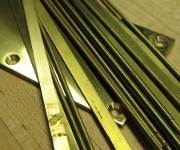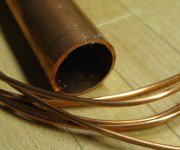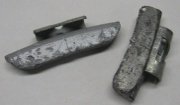Model Boat Materials - Metals
Find out how different metals can be used in building model boats and ships. Some examples include: brass, lead, steel and pewter.
Metal is one of the most important model boat materials, especially in mechanical components in working models, and where fine details can't be reproduced in any other material. Here is a run-down on the most common metals used in model boat building.
I buy most of the metal for my projects from Small Parts Inc. They have a great selection, fair prices and the cherry on top: free shipping on orders over $50. At the bottom of this page is a list of links for the metal I use the most.
Brass

|
Brass is probably the most common metal on model boats. On wooden ships you'll see pintle and gudgeon (the two halves of the "hinges" that hold the rudder), guns barrels, nails, eyelets etc. It'll work just about anywhere you want to substitute another metal.
For power model boats the most obvious parts to be made of brass are propellers and sometimes rudders. Brass is also useful for internal components for RC boats, such as home made rudder horns and other mechanical components. Brass wire makes good radio masts, handrails, cranes, davits etc.
Some other benefits as a model building material:
- Brass is a lot easier to work than stainless steel.
- It doesn't corrode like mild steel.
- It's harder and more resilient than copper.
- It solders easily with regular solder iron (unlike aluminum).
- It glues with CA and Epoxy, and can be painted or blackened.
- Many etched brass parts are available commercially.
Copper

|
Copper is also useful since it doesn't easily corrode, is relatively easy to form and solders and brazes well.
One thing to keep in mind: Epoxy doesn't adhere well to copper. This can be used to your advantage though. Copper wire (stripped electric wire) can be used to temporarily hold an epoxy glue-up together, such as the "stitch-and-glue" process.
Both Copper and brass are used extensively in boilers, cylinders, pistons and other components for live steam engines.
Steel
Steel doesn't have a lot of uses in model boat building because it rusts and corrodes so easily. Live steam again being an exception.
Steel can however be used as inexpensive ballast weights for working models - both RC and free running. Steel ballast weights needs to be painted or embedded in the hull for best result, well protected from any water that will seep in.
Piano wire is often used for servo push rods in RC boats. They will eventually rust and look tarnished and ugly, while still functional. I've gone away from piano wire and switched to straightened 17-4 PH stainless steel wire that I get from Amazon Industrial, formerly Small Parts Inc.
Lead

|
Due to it's high density, lead makes the best and most efficient ballast weights. A good ballast ensures that the center of gravity is as low in the hull as possible.
It should be pointed out that lead is branded as a 'heavy metal' and as such has been determined poisonous. If that is a concern of yours, then consider using steel instead. For many applications that may work well enough.
Lead is relatively inexpensive, but expensive to ship due to its weight. The best way to get free lead is to ask for used tire balance weights at one of your local tire service shops. Once removed from the rim of a vehicle they are scrap and I've had no problem receiving free weights at several occasions. The bigger issue is beating the competition to the punch, whether it be black powder bullet or fishing weight enthusiasts. The lead weights can be used as-is or melted into ingots or cast shapes.
For custom form-fit shapes without casting, reclaimed lead shot can be used. Once you've figured out how much weight you need, a volume in the hull can be lined with food film or aluminum foil. Next, place the shot and a wire-loop (so the weight can be pulled out of the hull easier) inside and fill with layup epoxy. They may not be pretty, but will fit perfectly.
Pewter or Britannia
Pewter is sometimes used as a model building material for various fittings. They can come with a kit, be purchased already made or you can cast them yourself. It's not terribly complicated. It is however somewhat outside the scope of this website.





